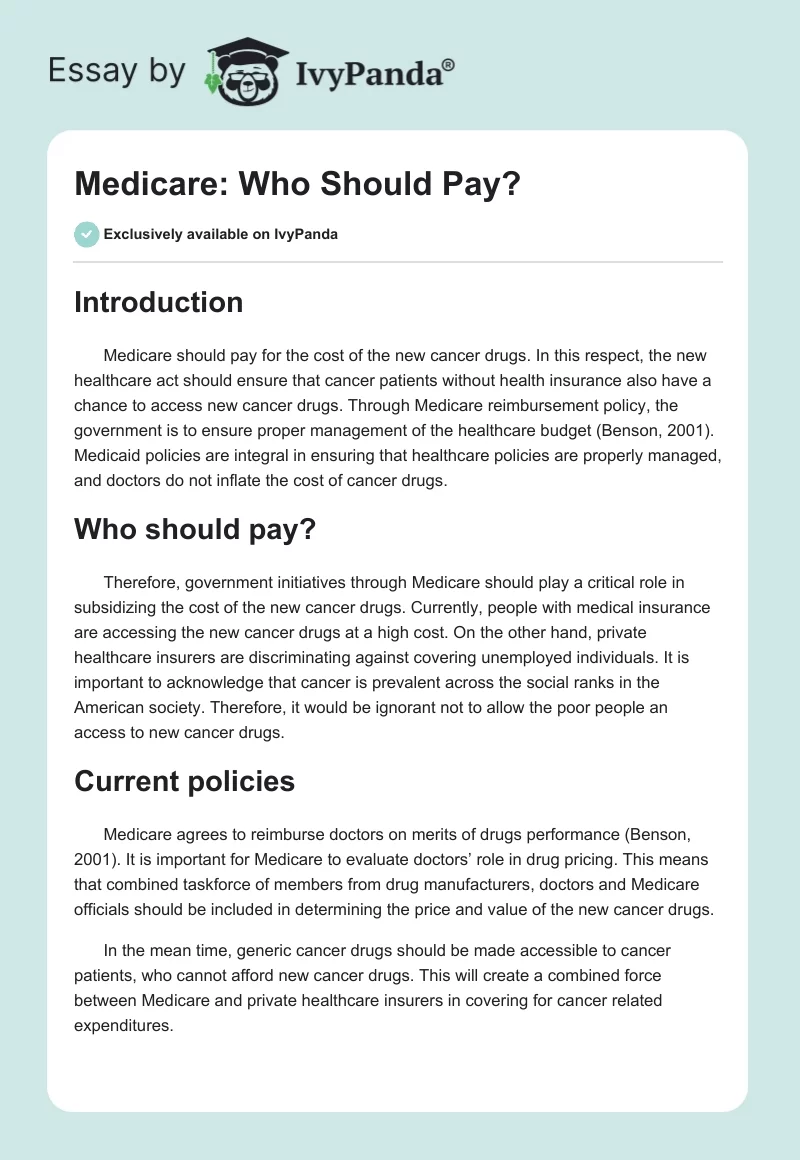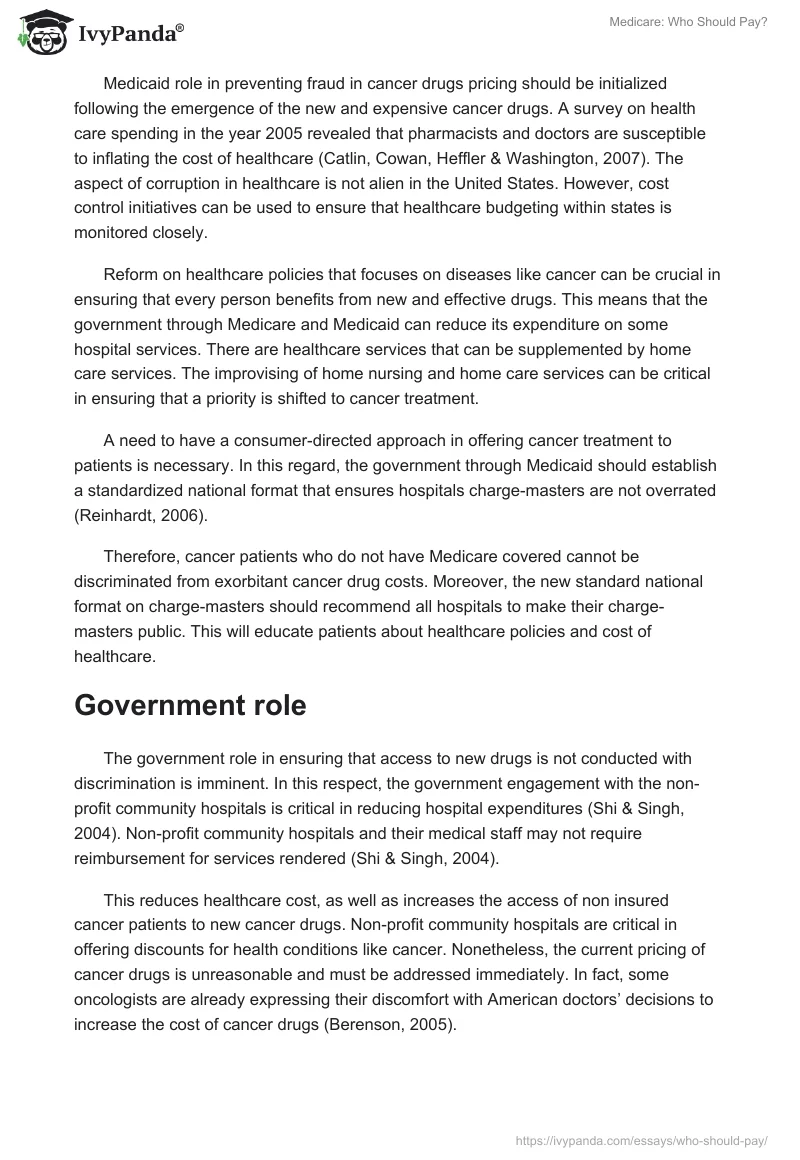Introduction
Medicare should pay for the cost of the new cancer drugs. In this respect, the new healthcare act should ensure that cancer patients without health insurance also have a chance to access new cancer drugs. Through Medicare reimbursement policy, the government is to ensure proper management of the healthcare budget (Benson, 2001). Medicaid policies are integral in ensuring that healthcare policies are properly managed, and doctors do not inflate the cost of cancer drugs.
Who should pay?
Therefore, government initiatives through Medicare should play a critical role in subsidizing the cost of the new cancer drugs. Currently, people with medical insurance are accessing the new cancer drugs at a high cost. On the other hand, private healthcare insurers are discriminating against covering unemployed individuals. It is important to acknowledge that cancer is prevalent across the social ranks in the American society. Therefore, it would be ignorant not to allow the poor people an access to new cancer drugs.
Current policies
Medicare agrees to reimburse doctors on merits of drugs performance (Benson, 2001). It is important for Medicare to evaluate doctors’ role in drug pricing. This means that combined taskforce of members from drug manufacturers, doctors and Medicare officials should be included in determining the price and value of the new cancer drugs.
In the mean time, generic cancer drugs should be made accessible to cancer patients, who cannot afford new cancer drugs. This will create a combined force between Medicare and private healthcare insurers in covering for cancer related expenditures.
Medicaid role in preventing fraud in cancer drugs pricing should be initialized following the emergence of the new and expensive cancer drugs. A survey on health care spending in the year 2005 revealed that pharmacists and doctors are susceptible to inflating the cost of healthcare (Catlin, Cowan, Heffler & Washington, 2007). The aspect of corruption in healthcare is not alien in the United States. However, cost control initiatives can be used to ensure that healthcare budgeting within states is monitored closely.
Reform on healthcare policies that focuses on diseases like cancer can be crucial in ensuring that every person benefits from new and effective drugs. This means that the government through Medicare and Medicaid can reduce its expenditure on some hospital services. There are healthcare services that can be supplemented by home care services. The improvising of home nursing and home care services can be critical in ensuring that a priority is shifted to cancer treatment.
A need to have a consumer-directed approach in offering cancer treatment to patients is necessary. In this regard, the government through Medicaid should establish a standardized national format that ensures hospitals charge-masters are not overrated (Reinhardt, 2006).
Therefore, cancer patients who do not have Medicare covered cannot be discriminated from exorbitant cancer drug costs. Moreover, the new standard national format on charge-masters should recommend all hospitals to make their charge-masters public. This will educate patients about healthcare policies and cost of healthcare.
Government role
The government role in ensuring that access to new drugs is not conducted with discrimination is imminent. In this respect, the government engagement with the non-profit community hospitals is critical in reducing hospital expenditures (Shi & Singh, 2004). Non-profit community hospitals and their medical staff may not require reimbursement for services rendered (Shi & Singh, 2004).
This reduces healthcare cost, as well as increases the access of non insured cancer patients to new cancer drugs. Non-profit community hospitals are critical in offering discounts for health conditions like cancer. Nonetheless, the current pricing of cancer drugs is unreasonable and must be addressed immediately. In fact, some oncologists are already expressing their discomfort with American doctors’ decisions to increase the cost of cancer drugs (Berenson, 2005).
In conclusion, Medicare should be paid for the cost of the new cancer drugs. All cancer patients have a right to receive the new cancer drugs irrespective of their healthcare insurance coverage. Therefore, the government should play a critical role in ensuring that Medicare, Medicaid, non-profit community hospitals and private health insurers help cancer patients in paying for new cancer drugs.
References
Benson, L. R. (2001). Reimbursing cancer care: Medicare policies challenged. Journal of the National Cancer Institute, 93(21), 1595-1597.
Berenson, A. (2005). Cancer drugs offer hope, but at huge expense. The New York Times, A1-C3. Retrieved from https://www.nytimes.com/2005/07/12/business/cancer-drugs-offer-hope-butat-a-huge-expense.html
Catlin, A., Cowan, C., Heffler, S., & Washington, B. (2007). National health spending in 2005: the slowdown continues. Health Affairs, 26(1), 142-153.
Reinhardt, U. E. (2006). The pricing of US hospital services: chaos behind a veil of secrecy. Health Affairs, 25(1), 57-69.
Shi, L., & Singh, D. A. (2004). Delivering health care in America. Burlington, Massachusetts: Jones & Bartlett Publishers.


